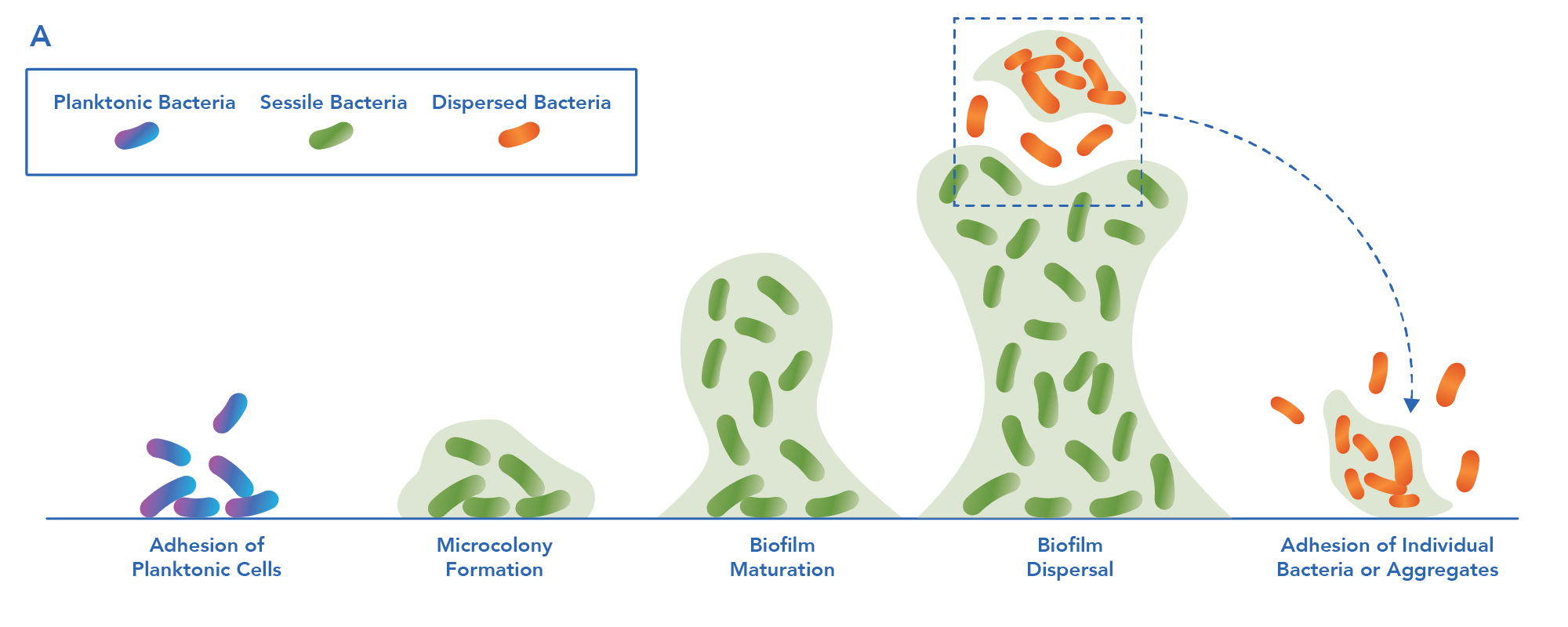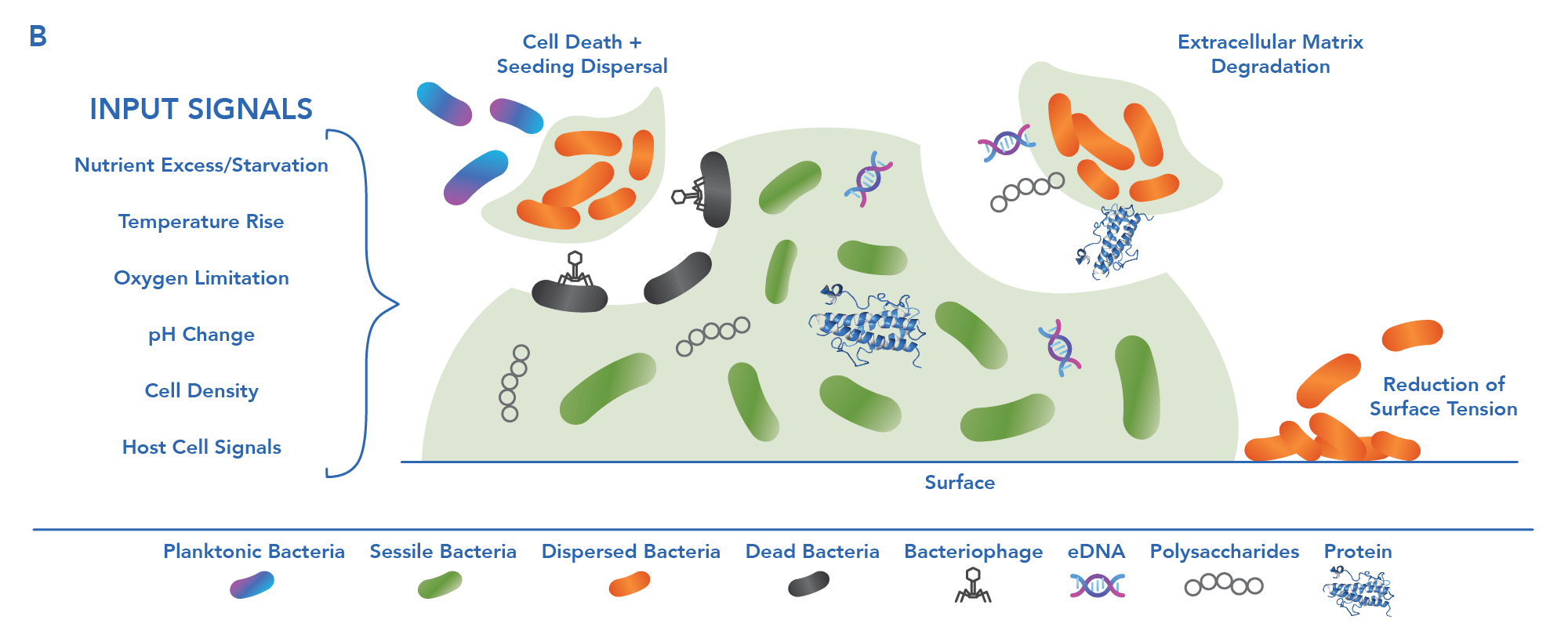In den meisten Verarbeitungs- und Umwelteinrichtungen lauern Biofilme als versteckte Bedrohung, die sich in schwer zugänglichen Bereichen verbergen und gefährliche Krankheitserreger beherbergen, die ein Risiko der Kreuzkontamination darstellen können. Wenn wir uns den Lebenszyklus der Bakterien innerhalb eines Biofilms genauer ansehen, finden wir eine weitere Ebene versteckter Gefahren: die Ausbreitung von Keimen.
In unserem ersten Grundlagen des Biofilms haben wir untersucht, wie Biofilme von frei schwimmenden Organismen gebildet werden, die sich an Oberflächen anheften und einen Biofilm bilden können. Der Biofilm besteht aus einer extrazellulären polymeren Substanz (EPS), einer Matrix aus Polysacchariden, Lipiden und Proteinen (López, 2010). Diese Organismen haben zwei Quellen: Sie werden von außen in das System eingeführt (Systeminputs) oder kommen von woanders her innerhalb das System, nachdem es sich von einem bereits gebildeten Biofilm gelöst hat. Biofilme werden durch unsachgemäße Reinigung und Entfernung zurückgelassen. Dieser Prozess wird als Seeding Dispersion bezeichnet.

Es gibt eine Vielzahl von Faktoren, die die Ausbreitung von Samen auslösen können. Entsprechend der Komplexität des Lebens hat sich gezeigt, dass Umweltfaktoren wie Nährstoffmangel oder -überschuss, Temperaturschwankungen, Veränderungen des pH-Werts oder des Sauerstoffgehalts Ausbreitungsmechanismen in Gang setzen können (Guilhen, 2017).
Sobald das Dispersionssignal von den Bakterien empfangen wird, lösen sich die Bakterien durch verschiedene Mechanismen aus dem Biofilm: entweder durch den Abbau der EPS-Matrix selbst durch sezernierte Enzyme oder durch zelluläre Veränderungen wie die Verringerung der Oberflächenspannung oder die Zerstörung der Zellstruktur. (Guilhen, 2017). Jetzt sind die Bakterien frei beweglich und können sich wieder an anderen Oberflächen festsetzen.

Um zu verstehen, welche Auswirkungen die Ausbreitung von Keimen auf Oberflächen in der Lebensmittelproduktion haben kann, ist es hilfreich, sich ein Beispiel aus der Praxis vor Augen zu führen. In einem einfachen, flüssigen Milchkreislauf werden Bakterien, die von Natur aus in der Rohmilch vorkommen, das System ständig beimpfen und einen Biofilm in allen Geräten mindestens bis zum Pasteurisierer bilden. Wird der Biofilm nicht vollständig entfernt und werden gefährliche Krankheitserreger während des Sanierungsprozesses nicht abgetötet, erhalten die etablierten großen Bakterienkolonien im System schließlich das Ausbreitungssignal und werden während der Produktion freigesetzt. Thermophile und sporenbildende Bakterien können den Pasteurisierungsprozess überleben und im weiteren Verlauf der Verarbeitungskette bis zum Homogenisierungsschritt oder sogar zur Endverpackung erneut Biofilme bilden. (Delgado, 2013). Dies ist ein ernstes Risiko für die menschliche Gesundheit.
Wir bei Sterilex sind stolz darauf, dass wir Experten sind, die wissen, wie Biofilm funktioniert und welche Risiken Biofilm für die Lebensmittelverarbeitung und andere Umgebungen darstellt. Unser PerQuat® Technologie ist die umfassendste Lösung zur Biofilmkontrolle auf dem Markt. Sterilex PerQuat-Produkte waren die ersten Produkte auf dem Markt, die bei der EPA registriert sind, um beide entfernen Biofilme im öffentlichen Gesundheitswesen und töten Krankheitserreger im Biofilm ab. Die kontinuierliche Verwendung von PerQuat-Produkten von Sterilex kann dazu beitragen, dass Ihr System vollständig sauber ist, indem Biofilm, Keimausbreitung und Systemverkeimung kontrolliert werden.
Quellen:
Lopez, D., Vlamakis, H., & Kolter, R. (2010). Biofilme. Cold Spring Harbor-Perspektiven in der Biologie, 2(7). doi:10.1101/cshperspect.a000398
Guilhen, C., Forestier, C., & Balestrino, D. (2017). Biofilm Dispersion: Mehrere ausgefeilte Strategien zur Verbreitung von Bakterien mit einzigartigen Eigenschaften. Molekulare Mikrobiologie, 105(2), 188-210. doi:10.1111/mmi.13698
Delgado, S., Rachid, C. T., Fernández, E., Rychlik, T., Alegría, Á, Peixoto, R. S., & Mayo, B. (2013). Diversität von thermophilen Bakterien in roher, pasteurisierter und selektiv kultivierter Milch, bewertet durch Kultivierung, PCR-DGGE und Pyrosequenzierung. Lebensmittelmikrobiologie, 36(1), 103-111. doi:10.1016/j.fm.2013.04.015